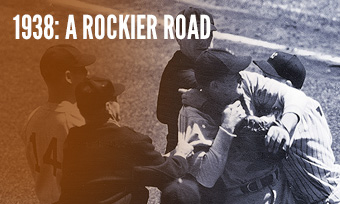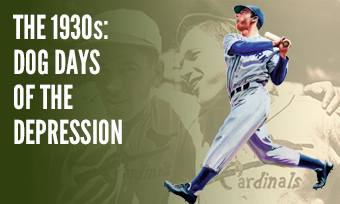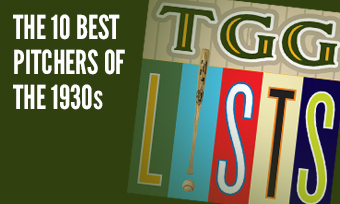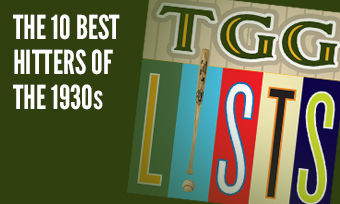The Yearly Reader
Leaders and Honors, 1938
Our list of baseball’s top 10 hitters and pitchers in both the American League and National League for the 1938 baseball season, as well as the awards and honors given to the game’s top achievers of the year.
The National League’s Top 10 Hitters, 1938
Bold type in brick red indicates league leader.
1. Mel Ott, New York
Key Numbers: .311 average, 116 runs, 36 home runs, 116 RBIs, 118 walks, .442 on-base percentage.
Ott’s one-year move to third base not only shored up a Giant weakness, but failed to distract him at the plate—reaching .300, 30 homers, 100 runs, 100 RBIs and 100 walks for the fourth and final time in his career.
2. Johnny Mize, St. Louis
Key Numbers: .337 average, 179 hits, 34 doubles, 16 triples, 27 home runs, 102 RBIs, 74 walks, .614 slugging percentage.
The Big Cat had his first two of six career three-homer games—seven days apart.
3. Joe Medwick, St. Louis
Key Numbers: .322 average, 100 runs, 190 hits, 47 doubles, 8 triples, 21 home runs, 122 RBIs.
One of baseball’s most ornery men of the moment led the NL both in doubles and RBIs for a third straight season.
4. Dolph Camilli, Brooklyn
Key Numbers: .251 average, 106 runs, 25 doubles, 11 triples, 24 home runs, 100 RBIs, 119 walks.
The Dodgers sent $45,000 and Eddie Morgan to the Phillies for Camilli. For the Phillies’ sake, the $45,000 hopefully was well spent—because Morgan never made it to the majors.
5. Ival Goodman, Cincinnati
Key Numbers: .292 average, 103 runs, 27 doubles, 10 triples, 30 home runs, 92 RBIs, 63 walks, 15 hit-by-pitches.
With Cincinnati’s Crosley Field becoming more of a hitter’s park after years of keeping pitchers happy, Goodman took advantage and became the first Red to hit 30, let alone 20, home runs; he actually led the NL in four-baggers into August before Mel Ott overtook him down the home stretch.
6. Johnny Rizzo, Pittsburgh
Key Numbers: .301 average, 97 runs, 167 hits, 31 doubles, 9 triples, 23 home runs, 111 RBIs.
The latest in a long line of 1930s rookies who enjoyed the honeymoon before pitchers quickly figured them out, Rizzo became the first player in Pirates history to hit 20 homers.
7. Arky Vaughan, Pittsburgh
Key Numbers: .322 average, 88 runs, 174 hits, 35 doubles, 5 triples, 7 home runs, 68 RBIs, 104 walks, 14 stolen bases.
Six did the trick for Vaughan, who batted .406 in the 47 games he was placed in the #6 spot of the batting order; otherwise, he had a relatively mundane .289.
8. Stan Hack, Chicago
Key Numbers: 152 games, .320 average, 109 runs, 195 hits, 34 doubles, 11 triples, 94 walks, 16 stolen bases, 15 caught stealing.
To show how lead-footed baseball had become, Hack’s 16 steals set an all-time NL low for a league leader.
9. Ernie Lombardi, Cincinnati
Key Numbers: 129 games, .342 average, 30 doubles, 19 home runs, 95 RBIs, 21 intentional walks, 14 strikeouts, 30 grounded into double plays.
The sharp-hitting but slow-footed catcher batted over .333 for the fourth straight year and became the first Red to win an MVP—and the first of three Reds to win it in succession, followed by Bucky Walters and Frank McCormick.
10. Wally Berger, New York-Cincinnati
Key Numbers: 115 games, .298 average, 79 runs, 16 home runs, 60 RBIs.
His early-decade dominance with the Braves neutered by injuries to the shoulder and hand, Berger found a brief resurgence of sorts with the Reds and former Boston manager Bill McKechnie after an early-season trade from the Giants.
The American League’s Top 10 Hitters, 1938
1. Jimmie Foxx, Boston
Key Numbers: .349 average, 139 runs, 197 hits, 33 doubles, 9 triples, 50 home runs, 175 RBIs, 119 walks, .462 on-base percentage, .704 slugging percentage.
Foxx had a full season’s worth of stats at Fenway Park alone, with 35 homers and 104 RBIs—but also showed that he wasn’t all downtown by winning his third batting title.
2. Hank Greenberg, Detroit
Key Numbers: .315 average, 143 runs, 175 hits, 58 home runs, 146 RBIs, 119 walks, 15 intentional walks.
Foxx was robbed of a second triple crown thanks to Greenberg and his pursuit of Babe Ruth’s season home run record; 39 of Greenberg’s blasts were hit at Tiger Stadium, and he had 11 multi-homer games overall to set an MLB record which still stands.
3. Joe DiMaggio, New York
Key Numbers: .324 average, 129 runs, 194 hits, 32 doubles, 13 triples, 32 home runs, 140 RBIs.
Missing nearly the first two weeks of the season due to his fabled contract holdout, DiMaggio ended up justifying his fight for a raise.
4. Harlond Clift, St. Louis
Key Numbers: .290 average, 119 runs, 25 doubles, 7 triples, 34 home runs, 118 RBIs, 118 walks, 10 stolen bases.
The Oklahoma native hit his career peak and especially came alive after the All-Star Break with 23 of his 34 homers—including 15 in August alone.
5. Jeff Heath, Cleveland
Key Numbers: .343 average, 104 runs, 172 hits, 31 doubles, 18 triples, 21 home runs, 112 RBIs.
The 22-year-old rookie kept Jimmie Foxx sweating to the end in the batting race, collecting 19 hits over his final 43 at-bats to finish a close second.
6. Charlie Gehringer, Detroit
Key Numbers: .306 average, 133 runs, 174 hits, 32 doubles, 5 triples, 20 home runs, 107 RBIs, 113 walks, 14 stolen bases.
The Mechanical Man played his last All-Star Game at age 35; he was the only player to see action in each of the first six Midsummer Classics.
7. Bob Johnson, Philadelphia
Key Numbers: .313 average, 114 runs, 176 hits, 27 doubles, 9 triples, 30 home runs, 113 RBIs, 87 walks.
The underrated Johnson showed he was more than just power by putting together a career-high 26-game hitting streak in midsummer.
8. Rudy York, Detroit
Key Numbers: 135 games, .298 average, 85 runs, 27 doubles, 33 home runs, 127 RBIs, 92 walks.
As if the Tigers didn’t need another hammer in their lineup, along came York, the burly slugger who powered on a year after smacking 35 taters over 375 at-bats.
9. Lou Gehrig, New York
Key Numbers: 157 games, .295 average, 115 runs, 170 hits, 32 doubles, 6 triples, 29 home runs, 114 RBIs, 107 walks.
Though slipping in overall productivity—a symptom perhaps related to the tragic events that lay ahead—Gehrig still managed to score and knock in 100 runs each for the 13th straight year.
10. Bill Dickey, New York
Key Numbers: 132 games, .313 average, 84 runs, 27 doubles, 27 home runs, 115 RBIs, 75 walks.
The Hall-of-Fame catcher belted 23 of his 27 homers and knocked in 84 of his 116 RBIs at Yankee Stadium.
The National League’s Top 10 Pitchers, 1938
1. Bill Lee, Chicago
Key Numbers: 2.66 ERA, 22 wins, 9 losses, .710 win percentage, 44 appearances, 37 starts, 19 complete games, 9 shutouts, 291 innings.
Four of Bill Lee’s NL-high nine shutouts came consecutively and, along with the majors’ two longest consecutive scoreless inning streaks (39 and 35.1) on the year, helped secure his only NL ERA title.
2. Russ Bauers, Pittsburgh
Key Numbers: 3.07 ERA, 13 wins, 14 losses, 40 appearances, 34 starts, 243 innings, 29 grounded into double plays.
The tall southpaw had a second straight solid campaign despite a lack of support, but it would all fall apart for him over the next couple of seasons due to a series of unfortunate events off the field that revealed a certain clumsiness about him.
3. Danny MacFayden, Boston
Key Numbers: 2.95 ERA, 14 wins, 9 losses, 19 complete games, 5 shutouts, 219.2 innings.
After spending the bulk of his career solely using a fastball that seldom got his ERA below 5.00, MacFayden wrapped up his third straight year south of 3.00 thanks to a more successful mix of deliveries.
4. Clay Bryant, Chicago
Key Numbers: 3.10 ERA, 19 wins, 11 losses, 44 appearances, 30 starts, 270.1 innings, 125 walks, 19 intentional walks, 135 strikeouts.
The closest thing to a NL version of Bob Feller, Bryant performed a September surge (6-1, 1.97 ERA in eight starts) that helped lift the Cubs to the pennant as much as Gabby Hartnett’s dusk-time homer.
5. Paul Derringer, Cincinnati
Key Numbers: 2.93 ERA, 21 wins, 14 losses, 41 appearances, 37 starts, 26 complete games, 307 innings, 49 walks.
Derringer clicked into his peak years with a workhorse effort that yielded a second 20-win campaign.
6. Bob Klinger, Pittsburgh
Key Numbers: 2.99 ERA, 12 wins, 5 losses, .706 win percentage, 159.1 innings.
Having escaped from the Cardinals’ voluminous minor league system, Klinger got his major league break at 29 and excelled for the Bucs.
7. Johnny Vander Meer, Cincinnati
Key Numbers: 3.12 ERA, 15 wins, 10 losses, 225.1 innings.
Besides his two straight no-hitters, Vander Meer also won the All-Star Game for the NL.
8. Ira Hutchinson, Boston
Key Numbers: 2.74 ERA, 9 wins, 8 losses, 36 appearances, 12 starts, 4 saves, 151 innings.
A reliever for the bulk of his eight-year career with only 31 starts among his 208 total appearances, Hutchinson was given more opportunity in the rotation but remained one of the Bees’ top bullpen bulwarks.
9. Freddie Fitzsimmons, Brooklyn
Key Numbers: 3.02 ERA, 11 wins, 8 losses, 202.2 innings, 43 walks.
Following in the footsteps of Rube Marquard over two decades earlier, the 37-year-old Fitzsimmons moved from tireless times with the Giants to a less oft-used yet more effective existence across town in Brooklyn.
10. Charlie Root, Chicago
Key Numbers: 2.86 ERA, 8 wins, 7 losses, 8 saves, 44 appearances, 11 starts, 160.2 innings, 30 walks.
When it came time to go to the bullpen in Chicago, the reliever of choice was the 39-year-old former ace, who pitched better than ever.
The American League’s Top 10 Pitchers, 1938
1. Lefty Gomez, New York
Key Numbers: 3.35 ERA, 18 wins, 12 losses, 20 complete games, 4 shutouts, 239 innings, 30 grounded into double plays.
Lefty didn’t commandeer the marquee statistical categories, but he got the critical outs when he needed to in order to reach the top of this chart.
2. Red Ruffing, New York
Key Numbers: 3.31 ERA, 21 wins, 7 losses, 22 complete games, .750 win percentage, 247.1 innings.
First there was Three Finger Brown, and then there was One Toe Red Ruffing, making it work for the Yankees despite his handicap brought on by a mining accident in another life.
3. Lefty Grove, Boston
Key Numbers: 3.08 ERA, 14 wins, 4 losses, .778 win percentage, 24 appearances, 21 starts.
Like Jimmie Foxx above, home would be a good thing for Grove, who won his last eight straight decisions at Fenway Park as part of a 20-game home streak that would last three years; an arm injury while fielding a bunt in July shortened his season.
4. Mel Harder, Cleveland
Key Numbers: 3.83 ERA, 17 wins, 10 losses, 4 saves, 38 appearances, 29 starts, 240 innings.
The veteran hurler won the same number of games as supersonic teammate Bob Feller with less than half the strikeouts—but also less than a third of the walks.
5. Thornton Lee, Chicago
Key Numbers: 3.49 ERA, 13 wins, 12 losses, 18 complete games, 245.1 innings, 26 grounded into double plays.
The big left-hander was unfairly starting to earn a reputation as a .500 pitcher and nothing more.
6. Spud Chandler, New York
Key Numbers: 4.03 ERA, 14 wins, 5 losses, .737 win percentage, 172 innings.
A modest full-time debut for the guy who’d go onto a career 109-43 record; a sore arm ended his season early in September.
7. Dutch Leonard, Washington
Key Numbers: 3.43 ERA, 12 wins, 15 losses, 223.1 innings, 53 walks, 11 wild pitches.
The knuckleballer had to wonder how he could have had a worse record and far better ERA than veteran teammate Wes Ferrell (13-8, 5.92 ERA).
8. Bob Feller, Cleveland
Key Numbers: 4.08 ERA, 17 wins, 11 losses, 39 appearances, 36 starts, 20 complete games, 277.2 innings, 208 walks, 240 strikeouts, .220 opposing batting average.
In his second full season, the 19-year-old Feller became the first pitcher to walk 200 batters, but made up as opponents hit an AL-low .220 against him.
9. Bobo Newsom, St. Louis
Key Numbers: 5.08 ERA, 20 wins, 16 losses, 44 appearances, 40 starts, 31 complete games, 329.2 innings, 192 walks, 226 strikeouts.
After finishing 16-20 in his previous one full year with the Browns, Newsom reversed the record in 1938—despite an ERA that was a full run higher. His 192 walks would have also broken the AL record had Bob Feller not conceded even more passes.
10. Monte Pearson, New York
Key Numbers: 3.97 ERA, 16 win, 8 losses, 27 starts, 17 complete games, 202 innings, 113 walks, 24 grounded into double plays.
Oh, how wonderful it was to be a Yankee pitcher in this day and age; Pearson’s so-so ERA was complemented with a chunky amount of wins thanks to a prodigious offense that provided him nearly seven runs per start.









